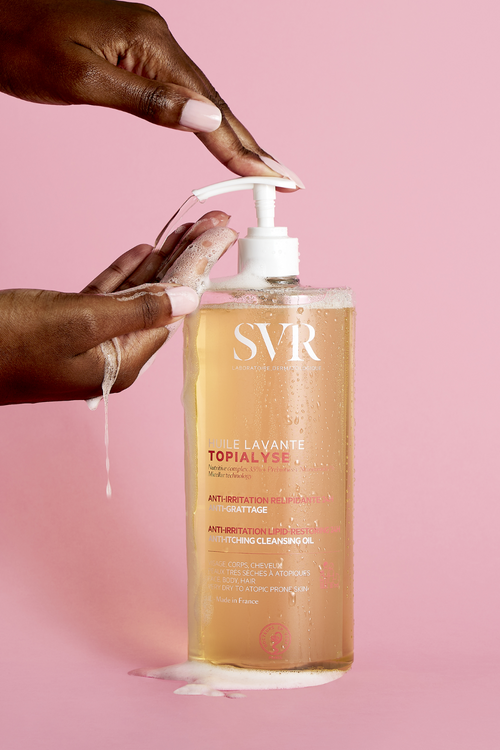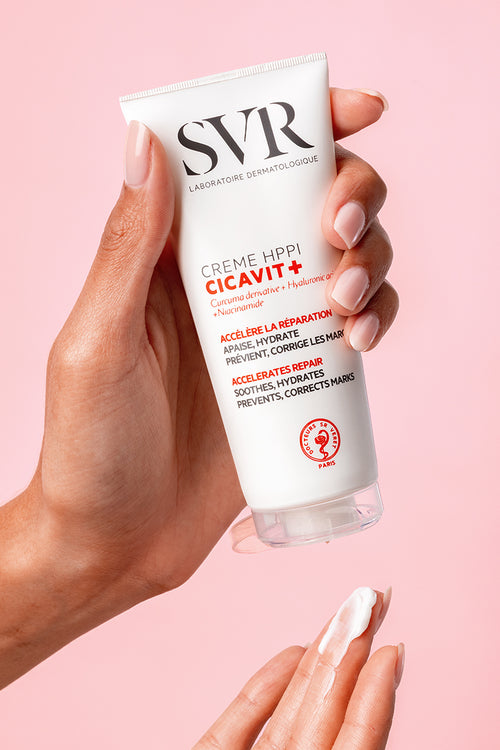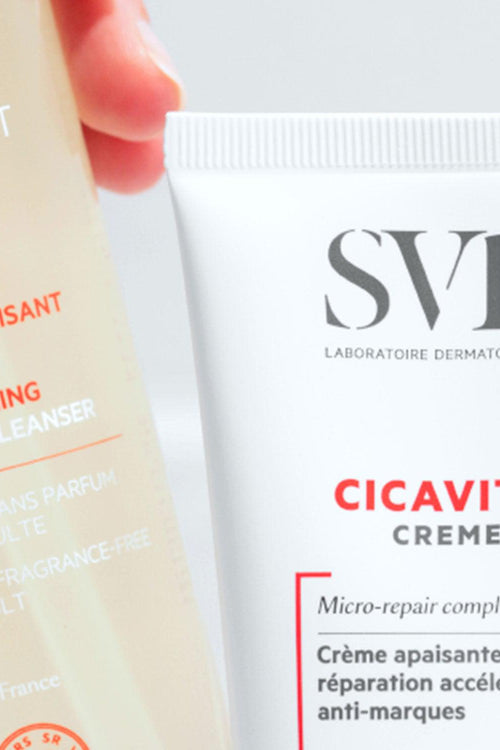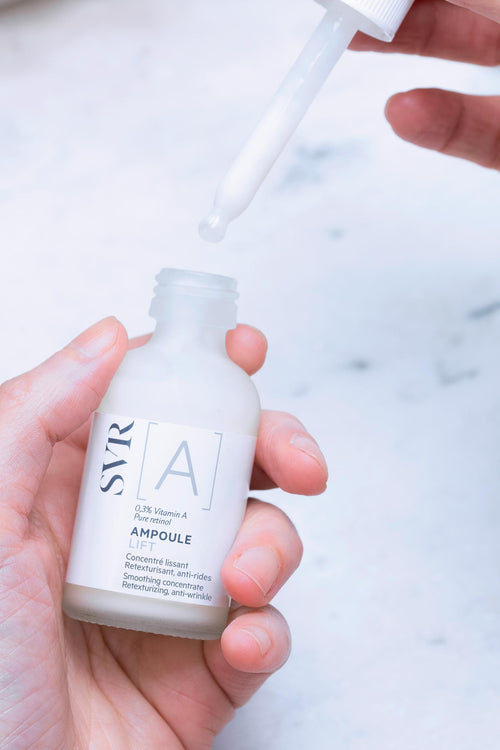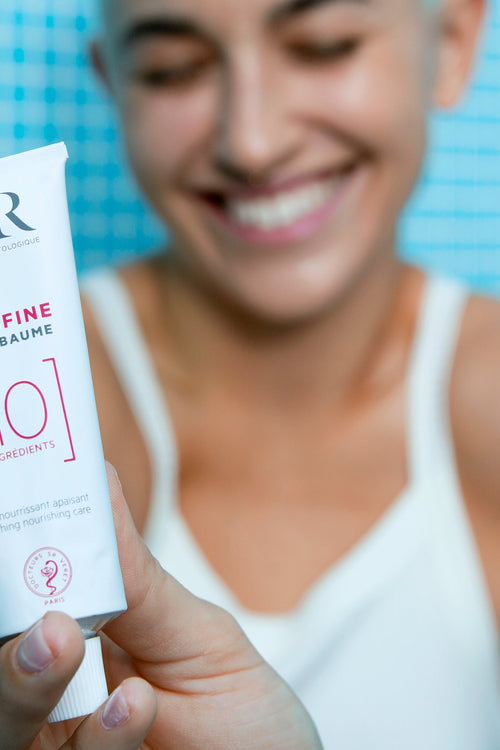Aging well thanks to cosmetics formulated with shock active ingredients
Over the years, what happens to the skin?
At the level of the epidermis which is thinning we observe a slowdown in cell renewal, dead cells accumulate on the surface of the epidermis, the complexion becomes duller. On the other hand, a reduction in hydration of the stratum corneum, a reduction in the adhesion of corneocytes and a reduction in lipid production lead to dryness and roughness of the skin with an alteration of the skin barrier. The number of melanocytes decreases (loss of 10% every 10 years) reducing the protective role against radiation and the appearance of pigmentation disorders.
At the dermo-epidermal junction:
This “border” between dermis and epidermis is essential for exchanges and communication between these parts of the skin. Very “hilly” when the skin is young, it flattens over time, which makes communication less effective and leads to the appearance of fine lines.
At the dermis level:
Fibroblasts – the cells of the dermis – lose quantity and quality. Their number decreases by half between the ages of 20 and 80. Their shape changes, making them less efficient. The production of collagen, the structural component of the skin, decreases by 1% each year. Its fibers become disorganized. Associated with a decline in elastin, this destructuring of the dermis results in a loss of elasticity, then in wrinkles. In addition , the extracellular matrix in which collagen and elastin bathe loses density because its main component, hyaluronic acid (a glycosaminoglycan), becomes rarer. Finally, the blood supply to the skin decreases and the collagen freezes by glycation (stiffening linked to sugars and oxidation): the complexion dulls and becomes yellower.
Target the right assets:
Modern cosmetics relies on safe active ingredients whose effectiveness has been scientifically proven.
Vitamins, stars of anti-aging:
- Vitamin PP or Vitamin B3 or N iacinamide , restorative
This vitamin, present in the body and involved in more than 200 enzymatic reactions in the body, is involved in the mechanisms of energy production by the cell and therefore in cellular repair. Depending on its dosage in a cosmetic product, it contributes to improving the barrier function of the skin, better hydration, acceleration of cell differentiation, healing or has anti-inflammatory effects (beneficial as well for aging as well as for acne or atopy) or anti-dark spots.
- Vitamin A , ( retinol and its derivatives ), stimulating
The molecule used by the body to promote cell renewal is in fact acidic Vitamin A, which can only be prescribed by dermatologists. In cosmetics, we therefore find molecules which transform into acidic vitamin A (known as precursors): encapsulated retinol, retinaldehyde, retinyl palmitate or linoleate, more stable and less irritating.
Retinol acts in all layers of the skin. On the surface, it has an exfoliating effect which promotes the unblocking of pores. It stimulates cell renewal and thus causes thickening of the epidermis. It also has a strong anti-oxidant role. In the dermis, it stimulates the production of collagen and elastin, increases the level of glycosaminoglycans (GAGs) and reduces the destruction of existing collagen. Therefore, it is a very good anti-wrinkle which also has an action on the homogeneity of the complexion.
- Vitamin C, super-vitamin
Although it is present in all plants, particularly fruits (citrus fruits, kiwi, acerola, etc.), L-ascorbic acid or vitamin C in cosmetics is generally synthetic. As its pure version, terribly effective, is also very unstable, it is generally used in the form of cures to be used as soon as the powder has been mixed with a solution. In serums or creams, it is stabilized, in particular by sugars.
It is one of the most powerful anti-oxidants. It is both directly and indirectly anti-radical, since it reactivates the effects of vitamin E, another super anti-oxidant. It boosts both the cells of the epidermis (keratinocytes) and those of the dermis. From two weeks of treatment, we see its action on the radiance of the skin. From one to two months of use, its action on the skin relief and the reduction of wrinkles, by stimulating collagen, appears. Finally, provided you are diligent for three months, it is a very effective anti-stain active ingredient. It therefore has an action on wrinkles, spots, skin relief and radiance of the skin.
- Hyaluronic acid, moisturizing and anti-wrinkle
Having become the super-star of anti-aging, this complex sugar present everywhere in the body (cartilage, skin, eyes) retains up to 1000 times its weight in water and is the most abundant component of the dermis. But be careful, there is not one but hyaluronic acids. Said to be of high molecular weight (large molecules which do not penetrate), it forms a moisturizing film, smoothes and fills in wrinkles on the surface of the skin by nestling there. Hyaluronic acid of very low molecular weight or fragmented infiltrates further into the epidermis where it is recognized by the cells which will themselves produce more hyaluronic acid. Then they will order the cells of the dermis to produce more collagen. It thus re-inflates the dermis mattress, plumps the skin and repels wrinkles from the inside.
- Fruit acids, multi-tasking
Also called AHA for alpha-hydroxy acid, these are acids derived, as they indicate, from fruit sugars: apple for malic acid, sugar cane for glycolic acid, grape juice for tartaric acid, lemon and citrus fruits (citric acid), fermented milk (lactic acid) but also in bitter almonds, honey… Today, they are synthesized. The most used are glycolic and lactic acids which have a particular ability to penetrate the skin.
Refined skin texture, radiance, reduction of spots, wrinkles and acne scars... their actions are multiple. They have moisturizing power because they transform part of the skin's keratin into amino acids, essential constituents of our natural hydration system, which makes the skin softer, smoother and more radiant. Fruit acids also have an exfoliating power because they reduce the cohesion of the cells of the stratum corneum, causing accelerated desquamation and therefore better cellular renewal of the epidermis. At the dermis level, in a treatment of at least one month, they help to reconstitute the cell environment (hyaluronic acid, collagen production, etc.), which promotes the smoothing of shallow wrinkles. The smallest ones, especially glycolic acid, can cause irritation and photosensitization. Sensitive skin prefers polyhydroxy acids (PHAs), such as gluconolactone, which are better tolerated.
- Anti -oxidants, protectors
Present in almost all plants (green tea, grapes, red fruits, citrus fruits), they help them defend themselves against external (cold, heat, UV, etc.) and internal (stress, oxidation) attacks. Polyphenols, resveratrol, co-enzyme Q10, vitamins C and E are part of this large family. Through their anti-radical effect, they protect the skin from oxidation and therefore slow down its aging. But in addition to being key molecules in anti-aging prevention, they have been discovered to have anti-glycation, fibroblast (and therefore collagen, elastin, etc.) and depigmenting properties.
- Peptides, messengers
These sequences of amino acids, constituents of proteins, are naturally present in the skin. Dipeptides, tripeptides… hexapeptides or polypeptides, the number of amino acids which constitute them determines their name. They act as messengers and attach to certain cell receptors to trigger various actions on their part. Some boost cell renewal, others lead to the synthesis of collagen and elastin, still others are hydrating or soothing, or even anti-glycation. Argireline, a hexapeptide, reduces expression lines. Proline boosts collagen synthesis...In short, the possible effects are multiple since almost each peptide corresponds to a specific action. Very expensive to produce, they are effective at very small doses.
- Calcium , fortifying
Our body is made up of 2% calcium, an essential mineral for the body and especially for our bones. It also has this strengthening role in the skin. However, the quantity of calcium present in the epidermis decreases, especially after menopause, and the skin becomes more fragile. Calcium in cosmetic treatments helps maintain good cohesion of the epidermal barrier. It helps it defend itself against external aggressions and to be less permeable to allergens and microbes. In addition, calcium promotes the transport of water through the epidermis and therefore promotes better hydration.
 |
To go further, Pauline Hauchecorne, our Director of Scientific Communication and Medical Visiting, enlightens us on which active ingredients to use according to your needs. |
Which active ingredient for each sign of skin aging?
Dehydration:
Dry and rough skin:
The hydration of the stratum corneum and the production of lipids decrease, the cohesion between the corneocytes is less good and consequently the barrier function of the skin is altered.
• Fruit acids such as glycolic or lactic acid, through their exfoliating properties, stimulate the renewal of the epidermis and brighten the complexion.
• We integrate daily UV protection into our routine to fight against photo-aging.
Dehydration lines, expression lines or aging lines, wrinkles are one of the first visible signs of skin aging, mainly on the face.
- Fine dehydration lines are due to poor hydration of the skin and are the first to appear.
- Expression lines are superficial wrinkles that are generally found on areas used by the muscles of the face: outer corner of the eye (crow's feet wrinkles), forehead and between the eyebrows (wrinkle of the lion), corner of the lips. On skin that loses elasticity over time, these folds, which are always the same, end up marking the skin tissues.
- Deeper aging lines are linked to skin sagging, loss of tone and firmness of the skin as well as the effects of external aging factors such as the sun. These are the wrinkles of the nasolabial fold, the wrinkles of the neck and those of the décolleté for example.
Loss of density, sagging skin :
With time and hormonal changes, the synthesis of the skin's essential components slows down: hyaluronic acid and collagen, key molecules in the skin's supporting tissue, become rarer. The architecture of the skin becomes fragile, loses density, relaxes and makes it less resistant.
• Low molecular weight hyaluronic acid is a major component of the Extra Cellular Matrix (ECM) and constitutes a key element in maintaining skin density.
Loss of elasticity and firmness
Over time, the production of collagen and elastin in the dermis slows down, leading to a reduction in the substances that make the skin elastic, particularly elastin.
• Retinol, by stimulating the production of fibroblasts, hyaluronic acid, collagen and elastin, restores suppleness and elasticity to the skin
• Low molecular weight hyaluronic acid will also be your ally. Thanks to its small size, it easily penetrates the different layers of the skin, absorbs water and stimulates the fibroblasts which ensure the suppleness of the skin.
Pigment spots :
With age, melanin, the pigment responsible for skin color, accumulates, particularly in areas frequently exposed to the sun (face, back of the hands, neckline). During exposure to the sun, pigmentation disorders appear in the form of brown spots.
• We choose vitamin C for its anti-oxidant and anti-free radical properties which protect the skin from sun-related damage. Thanks to its ability to regulate the activity of melanocytes which produce melanin, it reduces existing spots and prevents the appearance of new ones.
• Peptides are capable of inhibiting melanogenesis (formation of melanin) and therefore lightening the skin and reducing spots.
• Fruit acids, gentle exfoliants, also reduce stains.





